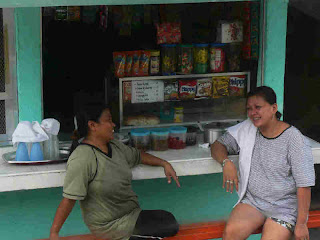Swim in the ocean – S & M
Walk along the beach – S
Wear flip-flops – S
Ride in a taxi – S & M
Eat squid, squid soup, jackfruit, pork intestines (sisig), lemon grass, ocean fish other than tuna– S & M
Eat white rice, corned beef – S
Drive a diesel, stick shift Jeep – S
Live in a house without a mirror, electricity (temporary) – S & M
Spend 1000 peso (P1000) notes – S & M

Speaking of spending P1000 notes, that can be quite difficult here, especially on Corregidor. That may not sound too unusual until you realize that P1000 is just about twenty US dollars. When we go to Manila we make sure that most of the money we bring back with us is P500 or smaller. P200 notes are handy here since it seems that 4 dollars is enough to buy a couple of meals or three big bottles of beer. But try to spend a P1000 note and you are often told they can’t change anything that large. It is strange to think that with P5000 in your pocket you’re really only talking $100.

The stores on Corregidor are for the most part sari sari stores, literal “all kinds.” Many of the island residents have little shops along the tourist route, and some even have them in their homes. It is a way to supplement their income. For them, P1000 is a lot of money, so it’s not surprising when they can’t make change. But we have even had trouble at the MacArthur Café at times, and it is the most established store on the island. Sari sari stores are prevalent throughout the Philippines, to the point where you often wonder how much any one store can sell in a day. The same is true for fruit stands along the roads, one after another, and nothing to distinguish one from the other, either.
Paper money denominations are 20, 50, 100, 200, 500and 1000 peso notes. They also have coins for 1, 5, and 10 pesos. On top of that some stores break down the price into sentimos, which are hundredths of a peso, a peso being about 2 cents. They have at least 5, 10, and 25 sentimo coins. It seems like you never spend such small coins, but you may end up with a pocketful that are worth about a nickel. We read that one of the Catholic bishops in Manila got the idea for people to throw their sentimos in collection cans at the counters of some of the stores that use sentimos for change, and the banks were asking the church to please turn them in because it was causing a shortage, so he must be being pretty successful. Certainly the poor in Manila can use every sentimo they can get.
The back of the P1000 has a picture of the world famous Banawe Rice Terraces. They are located north of the city of Baguio, about a day’s drive north of Manila. The terraces were built thousands of years ago and are supposed to be a sight to behold. We have not been there yet, but certainly we will some day. A
 book entitled something like “A Thousand Places to See Before You Die” lists them as one of two must-sees in the Philippines. The other is the Taal Volcano, which is actually a volcano within a lake, within a larger volcano within a lake. It is an hour or two drive south of Manila. We visited there five years ago but it was cloudy over the lake and we couldn’t see anything that day, so that’s another trip we’ll have to make some day.
book entitled something like “A Thousand Places to See Before You Die” lists them as one of two must-sees in the Philippines. The other is the Taal Volcano, which is actually a volcano within a lake, within a larger volcano within a lake. It is an hour or two drive south of Manila. We visited there five years ago but it was cloudy over the lake and we couldn’t see anything that day, so that’s another trip we’ll have to make some day.

No comments:
Post a Comment